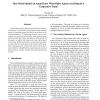26354 search results - page 13 / 5271 » How we refactor, and how we know it |
GECCO
2007
Springer
14 years 1 months ago
2007
Springer
Refactoring aims to improve the quality of a software systems’ structure, which tends to degrade as the system evolves. While manually determining useful refactorings can be cha...
ICMAS
1998
13 years 9 months ago
1998
Cooperation ina task oriented multi-agent team is important because a well designed cooperation strategy among a group of cooperating agents can lead to an increase of the group p...
ACMDIS
2000
ACM
14 years 1 days ago
2000
ACM
In this paper we propose a 3-step method for designing emotionally rich interactions, illustrated by the design of an alarm clock. By emotionally rich interaction we understand in...
CSE
2009
IEEE
14 years 2 months ago
2009
IEEE
Word-of-mouth communication has been shown to play a key role in a variety of environments such as viral marketing and virus spreading. A family of algorithms, generally known as ...
ECAL
2001
Springer
14 years 5 days ago
2001
Springer
Cognitive mechanisms are shaped by evolution to match their environments. But through their use, these mechanisms exert a shaping force on their surroundings as well. Here we explo...


